The mud team took a break from the brown stuff and dabbled a bit in white this morning. As a newly appointed (temporary) member of the sediment-team, I too, headed "down the brow". After preparing our equipment sleds we carried them down to the ramp where they were lowered onto the ice. Then, there was disembarking ourselves. What's missing from the picture below?
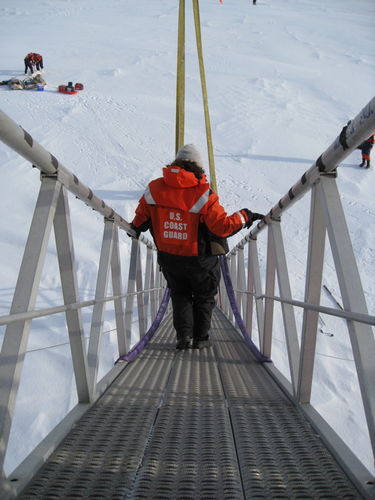
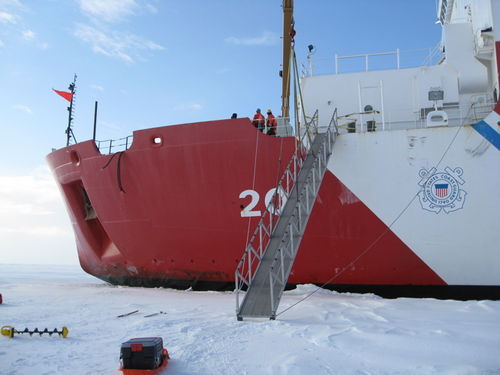
That's right, steps! Getting down to do ice-work seems like it would be easy but not it's not as easy as you would think. First, there's the bunny boots- huge, white clown shoes that spread your weight and protect your feet. Then, there's the MST900, a "dry suit", meaning many layers of waterproof insulation so that you are essentially Ziploc-ed into your outfit. The idea is that you would remain dry in the event that you fell through the ice.
Before anyone could set foot off the ship though, Captain Frederick Sommer held an ice safety briefing. During this meeting, he warned scientists and crew members about potential hazards. Today, he reminded the group to be extra careful when traveling down the brow. If someone falls or twists an ankle, he advised us that it could be over an hour to safely bring the person back up. Not quite the same thing as running down the stairs to recess! We walked.
Our orange-suited procession made it ankles intact to the ice. With our backs to the ship, all that could be seen to the horizon was flat, white, snow and ice. The head of the sediment science group, David Shull, began scouting for a suitably flat and seemingly thin spot in the ice to begin drilling. He used an auger to break through to seawater. Check out the video clip below... (You may have to watch it sideways, I'm learning!)
http://
So what does a scientist studying mud do once he makes a big hole in the ice? He takes out his bath toys! The ROV (remotely operated vehicle) is a very expensive Arctic bath toy with lots of cool features. First, there's the camera to record what the bottom of the ice sheet looks like. Then, there's the oxygen sensor that he added. There is also a light meter for testing "irradiance", light level in the water. David is pretty sure that no one else has attempted to gather information quite this way but he likes that it seems a bit crazy. He plans to use the information that he can gather with his homemade device to understand the changes that are happening in the local ecosystem. "One of the direct effects of earlier ice melt is the loss of sea ice algae. I'd like to know how important they are in feeding other organisms in the Bering Sea. I hope to measure and map ice-algae productivity using the oxygen sensor on an ROV that I can fly under the ice. This experiment is at the very early stage of development. I am still trying to prove the concept but the data we collected today indicates that it is working".
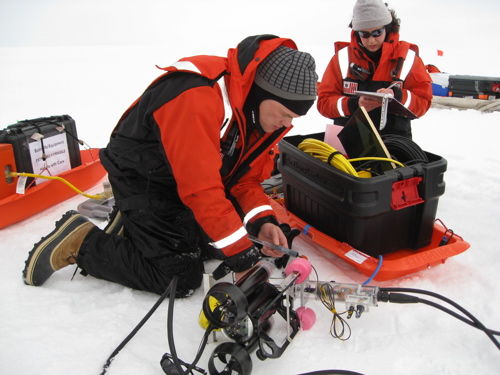
It took a few tries to get the ROV to act like it should, swimming right under the surface of the ice, taking pictures and gathering information while upright. A swimming noodle was cut up at one point and attached in some places to make the machine float just the right amount. Two hours and five or six attempts later though- paydirt! Pay algae, pay sea-ice? My roles in all this were ...1. Head Ice-Scooper/Splasher: I used a tool called the "chipper-dipper" to take ice out of the hole as much as possible. (There's lots of it ya know.)
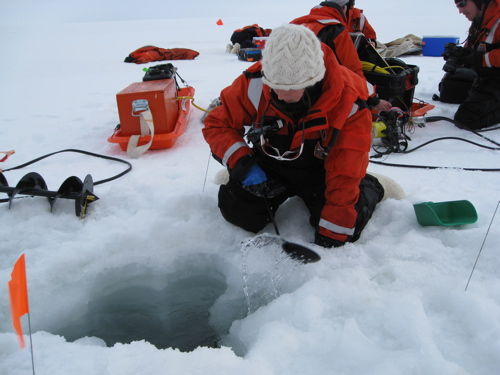
- Flag Manager: The safety flags that we put in place to mark our hole kept falling over and being blown away.3. Cord Unwinder/ Rewinder/ Detangler: Anyone who knows me is laughing right now at the thought of me being chosen for this job but I did it. Sort of successfully even.4. Polar Bear Patrol: I was secretly hoping and wishing for a sighting but no luck. Keep you posted!
Now we wait to "multi-core" again. There's repair work being done on the deck and we don't expect to begin until after 1700 hours. This means that we will be working through most of the night. While you are in class tomorrow, Ms. Welch will be Zzzzzzzz.....
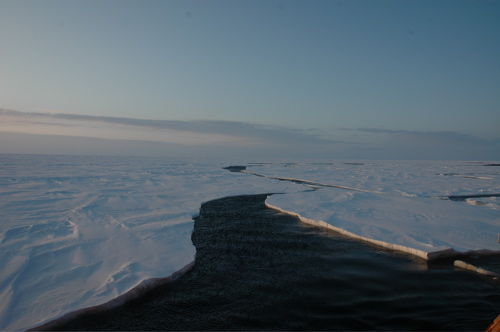


Comments